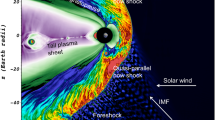Abstract
Space plasma simulation is a subject which is in its infancy, but which is already having an important impact on space science. Its growth is being spurred onward by the continuing increase in capacity (speed and memory) of computers and by advances in the sophistication of numerical models. These advances are making it possible to simulate more realistic situations using more complex models. Already significant three-dimensional MHD calculations of the magnetosphere and its interaction with the solar wind have been carried out. In addition multi-dimensional particle simulations are illuminating many of the microscopic physics processes which go on (instabilities, saturation levels and wave nonlinearity, shock structure, etc.). Notwithstanding these advances, the surface has only been scratched; many challenges and opportunities are provided by simulation both for the space physicist and the model builders (also for computer designers). In MHD models more physics need to be included (Hall effect, gyroviscosity, accurate models of boundaries, how do we put microscopic physics effects into macroscopic codes, etc.). For model builders correct treatments of systems containing a large range of important space and time scales, magnetic field strengths, Alfven wave velocity, etc. present real challenges. What are the best ways to diagnose these complex models and obtain meaningful information? What quantities should be looked at? How should they be displayed? A discussion of the promises, the prospects, and the challenges of the above topics will be given with examples taken from recent work.
Similar content being viewed by others
References
Leboeuf, J.N., Tajima, T., Kennel, C.F., and Dawson, J.M., Geophysical Research Letters8, 257 (1981).
Ogino, T., Walker, R.J., Ashour-Abdalla, M., and Dawson, J.M., ‘A MHD Simulation of the Bidependent Magnetospheric Convections and Field Aligned Currents During Northward IMS’, UCLA Preprint Report No. PPG-805 (1984).
Wu, C.C., ‘MHD Modeling of the Earth's Magnetosphere’, in Computer Simulations of Space Plasmas, H. Matsumoto and T. Sato (Eds.), D. Reidel Publishing Co. (1985).
Tajima, T., Leboeuf, J.N., and Dawson, J.M., ‘A Magnetohydrodynamic Particle Code with Force Free Electrons for Fluid Simulations’, J. of Computational Physics38 2 (1980).
Gekelman, W. and Stenzel, R.L., ‘Magnetic Field Line Reconnection Experiments: 6. Magnetic Turbulence’, J. of Geophysical Research89, A5 (1984).
Decyk, V.K., Ph.D. Thesis, Physics, UCLA (1977). Decyk, V.K. and Dawson, J.M., J. of Computational Physics 30. 407 (1979).
Author information
Authors and Affiliations
Rights and permissions
About this article
Cite this article
Dawson, J.M. The future of space plasma simulation. Space Sci Rev 42, 187–208 (1985). https://doi.org/10.1007/BF00218232
Issue Date:
DOI: https://doi.org/10.1007/BF00218232



